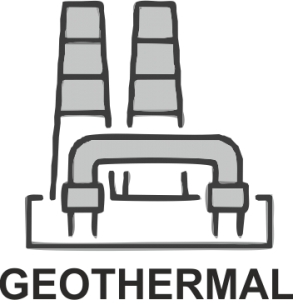Geothermal energy
Geothermal energy is thermal energy generated and stored in the Earth. Geothermal energy has been used for thousands of years in some countries for cooking and heating. It is simply power derived from the Earth’s internal heat. To produce geothermal-generated electricity, wells, sometimes a mile (1.6 kilometers) deep or more, are drilled into underground reservoirs to tap steam and very hot water that drive turbines linked to electricity generators. The first geothermally generated electricity was produced in Larderello, Italy, in 1904.
Underground reservoirs of steam and hot water can be tapped to generate electricity or to heat and cool buildings directly. A geothermal heat pump system can take advantage of the constant temperature of the upper three meters of the Earth’s surface to heat a home in the winter, while extracting heat from the building and transferring it back to the relatively cooler ground in the summer. Geothermal water from deeper in the Earth can be used directly for heating homes and offices, or for growing plants in greenhouses.
There are three types of geothermal power plants:
- Dry steam, the oldest geothermal technology, takes steam out of fractures in the ground and uses it to directly drive a turbine.
- Flash plants pull deep, high-pressure hot water into cooler, low-pressure water. The steam that results from this process is used to drive the turbine.
- In binary plants, the hot water is passed by a secondary fluid with a much lower boiling point than water. This causes the secondary fluid to turn to vapor, which then drives a turbine. Most geothermal power plants in the future will be binary plants.
Geothermal energy is generated in over 20 countries. The United States is the world’s largest producer, and the largest geothermal development in the world is The Geysers north of San Francisco in California.
Iceland
The National Power Company of Iceland currently operates 18 power stations all over Iceland, in five areas of operation making it one of the largest producers of renewable energy in Europe. 15 hydroelectric power stations, three geothermal power stations and two windmills. Iceland is a geothermal energy pioneer. Their unique geology, thanks to volcanism along a rift in the Eurasian tectonic plate and North American tectonic plate, provides a sustainable advantage: Heat from the ground. With this geothermal heat and innovative engineering, Iceland can provide hot water and electricity in their homes, warm their snowy streets, produce fresh local vegetables, and more. Around 25% of Iceland’s electricity comes from geothermal sources. Almost 100% of Iceland’s space heating and water heating is obtained from geothermal sources.



 This project (EDU-ARCTIC) has received funding from the European Union’s Horizon 2020 research and innovation programme under grant agreement No 710240. The content of the website is the sole responsibility of the Consortium and it does not represent the opinion of the European Commission, and the Commission is not responsible for any use that might be made of information contained.
This project (EDU-ARCTIC) has received funding from the European Union’s Horizon 2020 research and innovation programme under grant agreement No 710240. The content of the website is the sole responsibility of the Consortium and it does not represent the opinion of the European Commission, and the Commission is not responsible for any use that might be made of information contained.